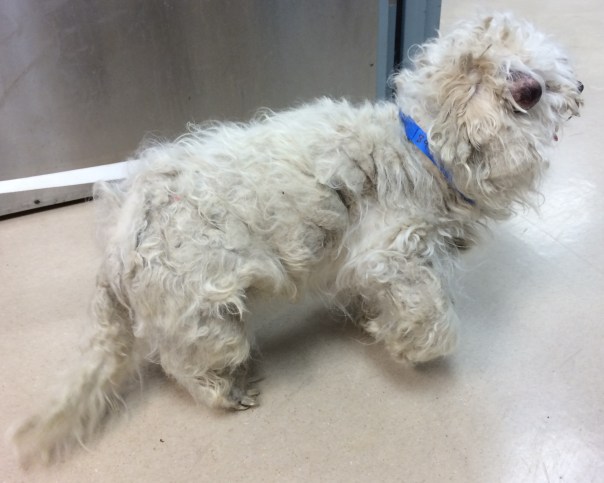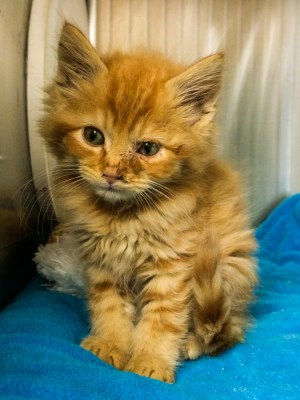Before & After – Shelter Vet Removes Large Mass, Saves Dog’s Vision
I received a phone call from a veterinary technician at the San Jose Animal Care Center on the weekend informing me that a dog had just come in with a large ulcerated mass coming out of its eye. Without any photo or video to aid my imagination, I started to picture what the technician was describing and prescribed pain medication and antibiotics to keep the dog comfortable and to fight off infection before I could examine it in person on Monday.
When I came into work on Monday, I found what was clearly a very happy dog, albeit with a large mass on its head that seemed to arise from the left eye or the area around that eye. It was not possible to visualize any part of the left eye.
No Eyes? No Problem! Blind Dogs Find Forever Homes Too!
You may think that a dog or cat without any eyes would never be put up for adoption. In some shelters that may be the case. Not at the San Jose Animal Care Center (SJACC).
At SJACC, the veterinarians evaluate each animal that comes in for medical issues. Being blind is not necessarily an indicator of a medical condition that would prevent an animal from being adopted. As long as the animal is otherwise healthy, being able to see is not necessarily going to impact quality of life, especially for animals that slowly lose their vision over time as is the case for many animals with cataracts.
A recent dog who came into the shelter was surrendered by its owner for euthanasia because the dog had been blind for two years and the owner did not believe that was a good quality of life for the dog.
Lab Mix with Degloving Injury Gets Second Chance with Three Legs
When Chance first came into the San Jose Animal Care Center (SJACC), it was evident that his left hind leg was badly injured, reportedly after he was hit by a car. Chance had suffered a degloving injury, which means that the skin was missing from his leg, leaving the bones in that area exposed. To make things worse, the bones in the affected area of Chance’s leg were not attached and connected like they should be. The injury was gruesome, but Chance was otherwise in good health and spirits.
Veterinarians at SJACC made sure Chance was comfortable by giving him pain medications along with antibiotics to fight infection. The vets bandaged and splinted Chance’s leg and changed it daily while waiting for an owner to come to the shelter and claim him. The wet-to-dry bandages also served to clean out the wound from dirt, debris, and dead tissue, allowing fresh tissue to take over.
San Jose Shelter Pushes Forward and Strives to Save More Kittens Each Year
The summer is when kitten season is in full swing. Because cats are such prolific reproducers, animal shelters tend to become overrun with kittens during the summer months (or, more accurately, most of the year in California animal shelters). With such a high influx of kittens, it is often hard for shelters to keep up with them and the care they require.
Many shelters euthanize kittens under two pounds upon entering the shelter, even if they are healthy. You can imagine what the fate is for kittens that are not healthy. The San Jose Animal Care Center (SJACC) does not follow this practice. Rather, the SJACC has worked hard to save a higher percentage of kittens each and every year and has gradually decreased the weight at which the shelter’s veterinarians feel it is safe to perform surgery (using special protocols for these fragile mini-kitties) and adopt out kittens. As of 2014, the minimum weight kittens must be for surgery to be performed at SJACC is 1.3 pounds.
RESCUE SPOTLIGHT: Atticus the Great Dane Rescued by St. Francis
One morning at the shelter I saw a dog that was written on the vet board for “drinking excessively, needed second water bowl.”
The vet board is a way for shelter staff and volunteers to communicate to the veterinarians that an animal may need medical attention. Drinking excessively is referred to as polydipsia in the veterinary field and can be associated with a plethora of medical issues such as urinary tract infections, pyometra, kidney disease, Cushing’s, Diabetes and more!
Without knowing anything more, these diseases and their manifestations started flowing through my head as I walked to the kennel where the dog was being housed.
As I walked up to meet Atticus, I smiled.
I was so happy to see that the dog that needed a second water bowl was nothing smaller than a Great Dane. His large stature made his kennel seem small and cramped, which was exaggerated by the comparative small stature of the 5-pound chihuahua next door.
San Jose Shelter Teams Up to Fix Dog’s Busted Knee
The scruffy, out-of-control hairdo on this 10-pound female pooch was perhaps the first thing you would have noticed. The second thing you would likely have noticed is that she walked strangely. Her left hind leg didn’t do much. It mostly just dangled.
Veterinarians were alerted to her unusual gait and she was examined. Her leg was palpated and manipulated in various ways to evaluate whether there were broken bones, disrupted ligaments, pain, or nerve damage.
It was quickly determined that the issue was with her knee. Small dogs tend to have patellas (kneecaps) that luxate, known as MPL for Medial Patellar Luxation, which means that the patellas move out of their normal place and cause the dog to have an awkward and possibly uncomfortable gait. MPLs are graded on a scale of 1 to 4 with 4 being the most severe.
This dog’s leg was very strange. While the patella was indeed severely luxated – a grade 4 – there was also another component. Her leg felt very flaccid. Dr. Ostermann performed a drawer test on the dog and determined that she had ruptured one of her cruciate ligaments in her knee (analogous to an ACL tear in humans).
With such a severely affected leg, there was a question as to whether the leg would even be worth saving. To answer that question, the veterinarians at the San Jose Animal Care Center (SJACC) contacted specialty practice veterinarians at SAGE Centers and asked for their recommendation.
Poodle Mix with Irreversible Quadriceps Contracture
In June we had a Poodle Mix in our care at the San Jose Animal Care Center that had a peg leg. Essentially the dog’s right hind leg was not able to bend in a normal way so it just stuck out and got in the way and impeded her mobility.
Although there is no way to know this dog’s history, we believed that this dog had fractured the femur on the right hind leg and it was not given swift and proper care, resulting in what is known as quadriceps contracture.
The following is what the Merck Veterinary Manual has to say about the condition:
“Quadriceps Contracture (Quadriceps Tie-Down, Stiff Stifle Disease)
This serious fibrosis and contracture of the quadriceps muscles develops secondary to distal femoral fractures, inadequate surgical repair, and excessive dissection in young dogs. Adhesions develop between the bone, periosteal tissue, and quadriceps muscles, which lead to limb extension, disuse, osteoporosis, degenerative joint disease, and bone and joint deformations. Clinical signs include hyperextension and cranial displacement of the affected limb. Surgery is usually required to resect fibrous tissues and increase motion of the stifle joint. Bone and soft-tissue reconstructions along with postoperative flexion bandages and physical therapy are required to recover limb function. Prognosis is guarded. Prevention of the condition by accurate, biologic stable repairs of bone fractures is preferred.
While there are options available to treat animals with femur fractures so as to minimize or eliminate the risk of quadriceps contracture, it can happen fast (within a day) and be permanent! Fast surgical correction of the fracture paired with rehabilitation is often the key to preventing it from happening. If you are looking for a rehabilitation facility in your area, please visit the Canine Rehab Institute’s page and select Find a Therapist.
Unfortunately, this dog was not so lucky and had been living with this leg for who knows how long.
The only option for this dog was surgery to amputate the burdensome leg.
In the following two photos you can see abnormal positioning of the dog’s right hind leg. This is particularly evident when the leg is manipulated in the second photo but does not bend in a normal way, but rather remains locked.
Turtle Likely Hit By Car, Sustains Trauma to Shell
A red-eared slider showed up in a box at the medical clinic of the San Jose Animal Care Center with a note indicating that it had been injured. I opened the box to examine the turtle and determine a course of action.
The turtle was a good size and the damage was obvious. It had sustained trauma to the carapace (shell) around the tail.
There was an area where the carapace was missing a large chunk, just over the tail, and a few other fractures in the carapace in that region.
While there was no way to know for sure what happened, it looked as if this turtle’s shell had an encounter with the tires of a vehicle.
Before & After – Mass Removal and Grooming Brought Out the Happy in This Poodle Mix

Take one look at this 3 year old Poodle mix and you may wonder how we ever decided he was a Poodle mix. His coat was so overcome with mats from not being groomed that he moved as if it was burdensome, perhaps even painful. Yet you could see that with the subtle wag of his tail, he wanted so much to be loved.
You might not be able to see it, but this dog had a large, pendulous mass hanging down over his right eye (it might look like an ear to you). His matted coat obscured much of the mass, but it was sizable and clearly in the way.

Before





